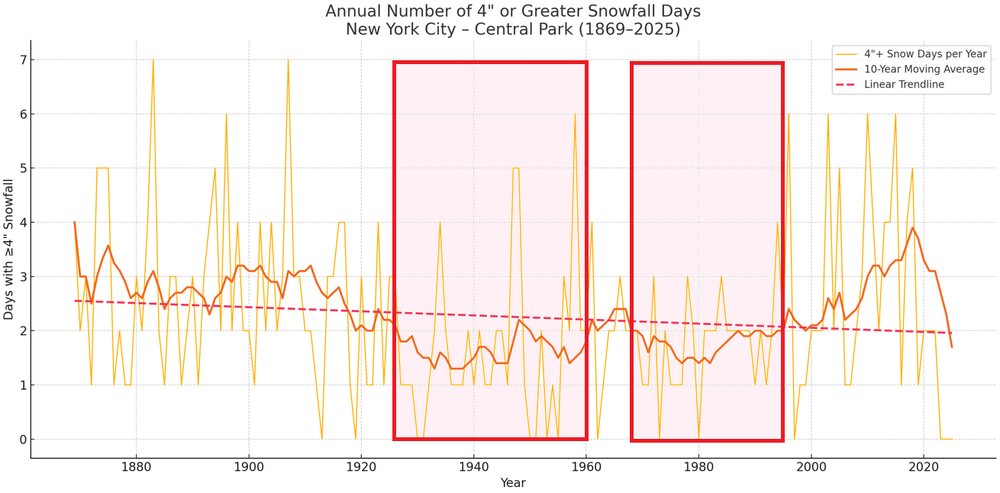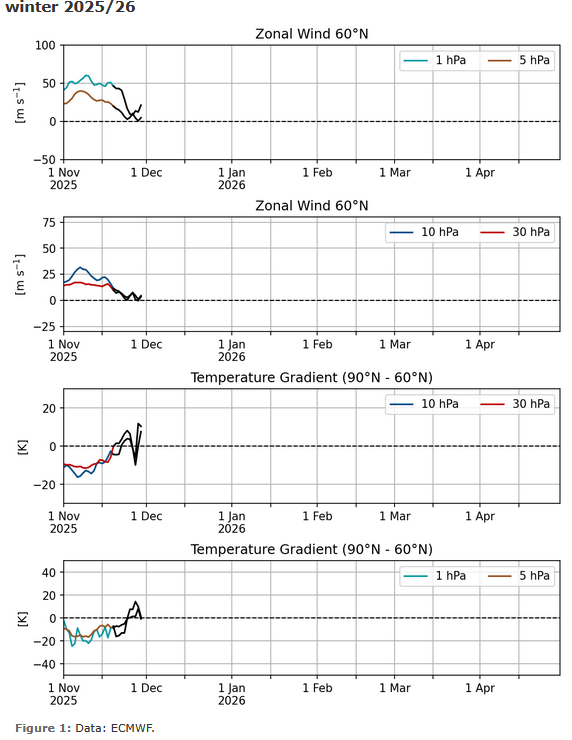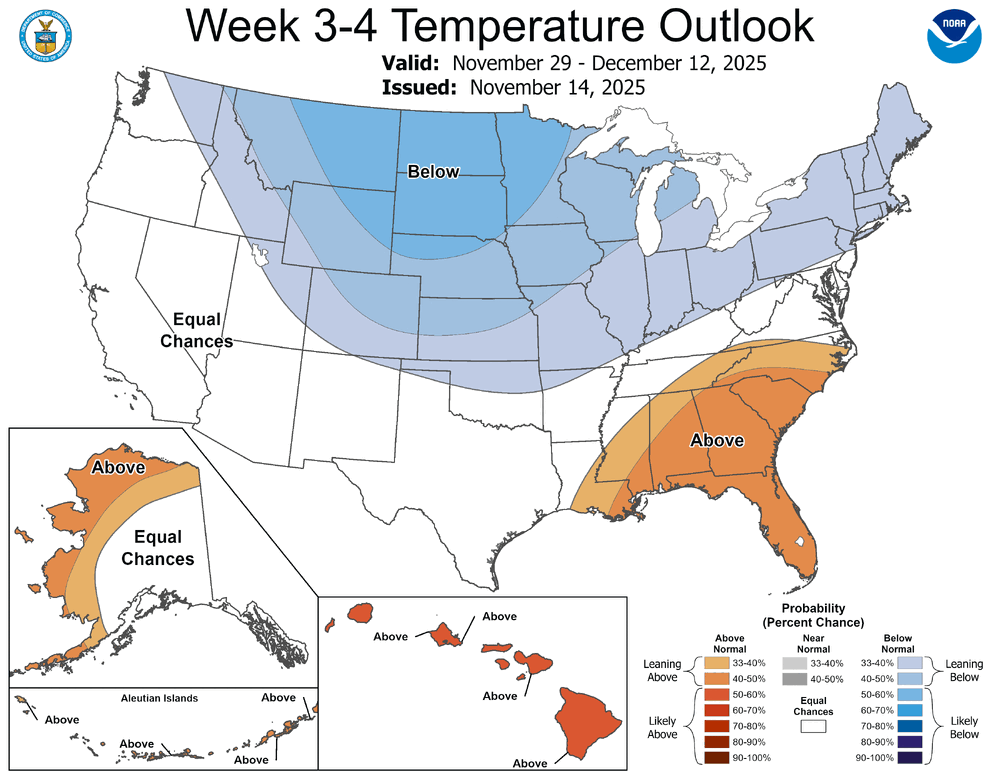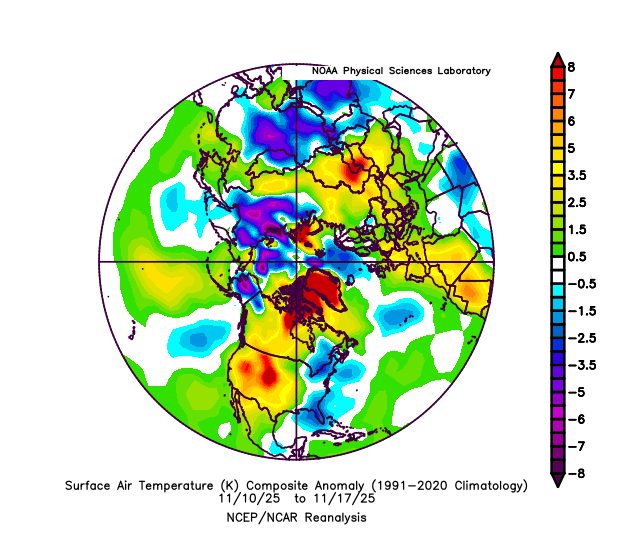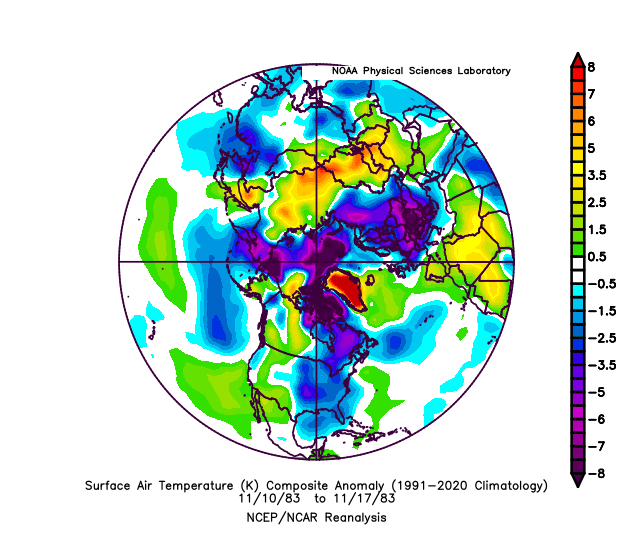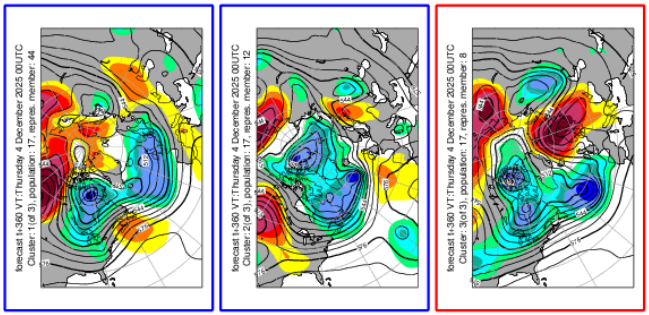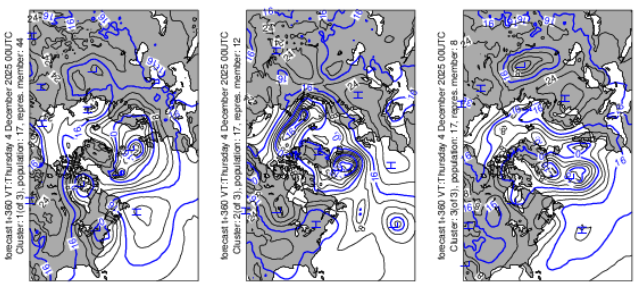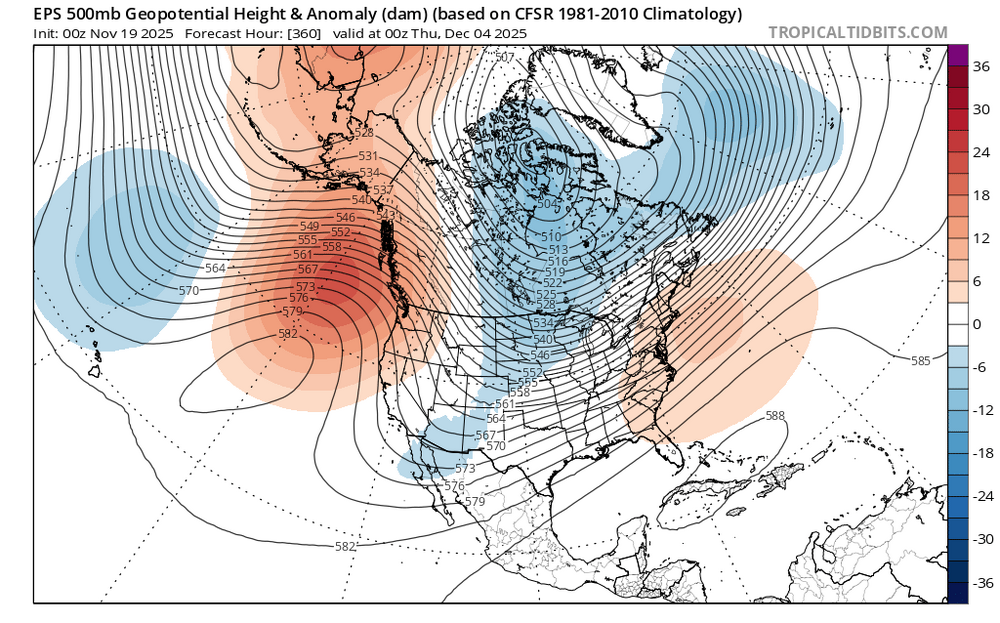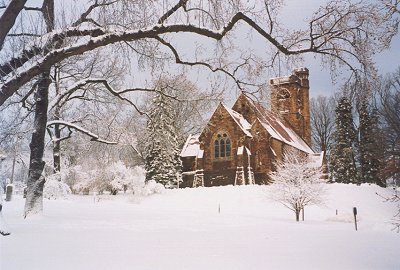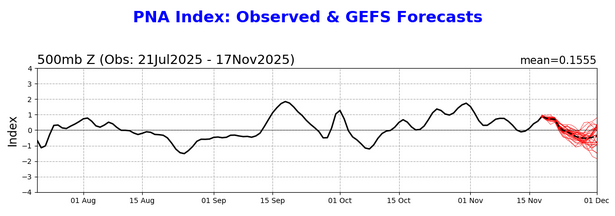-
Posts
23,129 -
Joined
Content Type
Profiles
Blogs
Forums
American Weather
Media Demo
Store
Gallery
Everything posted by donsutherland1
-
It will turn milder tomorrow. Once in place, the generally milder than normal pattern will likely continue into the closing days of November. However, exceptional warmth appears unlikely. The closing days of November could turn cooler. Meanwhile, today will be Central Park's 1,391st consecutive day without daily snowfall of 4" or more. The record of 1,394 days was set during February 22, 1929 through December 16, 1932. That stretch ended with 6.7" daily snowfall on December 17, 1932. The ENSO Region 1+2 anomaly was -0.7°C and the Region 3.4 anomaly was -0.7°C for the week centered around November 12. For the past six weeks, the ENSO Region 1+2 anomaly has averaged -0.16°C and the ENSO Region 3.4 anomaly has averaged -0.65°C. La Niña conditions will likely continue through at least mid-winter. The SOI was +31.43 today. The preliminary Arctic Oscillation (AO) was -0.316 today. Based on sensitivity analysis applied to the latest guidance, there is an implied 78% probability that New York City will have a cooler than normal November (1991-2020 normal). November will likely finish with a mean temperature near 46.9° (1.1° below normal). Supplemental Information: The projected mean would be 0.8° below the 1981-2010 normal monthly value.
-
It's something we should be watching closely. The SSWE is imminent. Considering a typical 10-30-day lag, I suspect that the December 10-25 period might see the coldest anomalies relative to normal for such cities as Chicago, New York, and Philadelphia. That's still far out and we'll have to see how things evolve (does the PV split, where do the twin vortices wind up, etc.).
-
Yes. Since 2020, Pittsburgh has had 7 such days while New York City has had 6. Temperatures have not warmed so sharply and abruptly that such storms are precluded. I suspect that this winter will see at least one such day in both cities. It should also be noted that New York City has gone through two long stretches where 4" or above snow days were infrequent.
-

2025-2026 ENSO
donsutherland1 replied to 40/70 Benchmark's topic in Weather Forecasting and Discussion
There have been some subtle shifts in the guidance. The combination of subtle shifts and long timeframes can lead to big changes. But the timeframe involved is speculative and skill scores at that timeframe are essentially non-existent. What remains extremely likely is that a sudden stratospheric warming event (SSWE) is imminent. Zonal winds will slacken dramatically during the next 5-7 days. A full reversal can't be ruled out. There is typically a lag of 10-30 days for the impact of an SSWE to propagate to the troposphere. So, even as a cold shot appears increasingly likely from the Great Lakes Region to the Northeast to close November, that cold shot will almost certainly not be the result of the imminent SSWE. What happens with the polar vortex (split and location of the pieces) will be crucial. For now, things still appear on a path toward an EPO-/WPO-/AO-/PNA- pattern development. Initially the most significant cold appears likely to dump into the Plains States before pushing eastward. The Great Lakes Region still seems primed for a possible multi-week period of below normal temperatures coupled with above normal precipitation. That should lead to an increase in snowfall totals in such cities as Chicago, Detroit, Windsor, and Toronto. Pieces of the cold should begin to bleed into the East, but perhaps after the first 7-10 days of December. If things evolve along this baseline scenario, the December 10-25 period might see the coldest anomalies relative to normal for such cities as Chicago, New York, Philadelphia. The Southeast could see some intrusions of cold, but the PNA- could promote an unwelcome and persistent tendency for SE ridging. Newer guidance suggests an increased probability of a negative NAO, so that could flatten the SE ridge at times. This is my baseline thinking. IMO, the Week 3-4 CPC Outlooks capture the temperature idea of kind of pattern I expect to prevail during the first half of December. Despite social media chatter 1983-style Arctic outbreaks, a lot would need to change for such an outbreak to become likely. Currently, the Northern Hemisphere's cold pool is much smaller than it was at this time in 1983: 2025: 1983: In the very long range, some of the subtle shifts in the teleconnections e.g., dissipation of the WPO-, could translate into the trough's migrating back to the West and a Southeast Ridge reviving in the closing week of December. That's not shown on the weekly ECMWF guidance. But the December 22-29 period's 500 mb forecasts should be monitored for hints of change. It should be noted that neither the MJO nor teleconnections can be forecast with skill at such a forecast horizon. In sum, wintry opportunities should increase in December, first in Plains States and Great Lakes and then farther East. The Great Lakes Region and Ohio Valley look primed for above normal snowfall during December. The Southeast could have the most difficult time seeing the cold try to gain traction, but some cold shots should eventually break through. The closing week of December looks uncertain. Much depends on how the SSWE's impacts will evolve and other variables that cannot be forecast with skill at that range. Typical SSWE lags would argue that the breakdown in the pattern might occur later. Then there's always the wild card of additional warming events. -

2025-2026 ENSO
donsutherland1 replied to 40/70 Benchmark's topic in Weather Forecasting and Discussion
I used the NE as an example, because it seemed that a lot of the commentary had been focused on the NE U.S. -
Below normal temperatures will prevail through tomorrow. Highs will be mainly in the middle and upper 40s in New York City with lows in the middle and upper 30s. A milder pattern will then develop afterward. Some rain or rain showers are possible. Once in place, the milder pattern will likely continue into the closing days of November. However, exceptional warmth appears unlikely. The closing days of November could turn cooler. Meanwhile, today will be Central Park's 1,390th consecutive day without daily snowfall of 4" or more. The record of 1,394 days was set during February 22, 1929 through December 16, 1932. That stretch ended with 6.7" daily snowfall on December 17, 1932. The ENSO Region 1+2 anomaly was -0.7°C and the Region 3.4 anomaly was -0.7°C for the week centered around November 12. For the past six weeks, the ENSO Region 1+2 anomaly has averaged -0.16°C and the ENSO Region 3.4 anomaly has averaged -0.65°C. La Niña conditions will likely continue through at least mid-winter. The SOI was +38.30 today. That is the highest SOI value since December 23, 2022 when the SOI reached +50.96. The preliminary Arctic Oscillation (AO) was -1.027 today. Based on sensitivity analysis applied to the latest guidance, there is an implied 74% probability that New York City will have a cooler than normal November (1991-2020 normal). November will likely finish with a mean temperature near 47.1° (0.9° below normal). Supplemental Information: The projected mean would be 0.6° below the 1981-2010 normal monthly value.
-

2025-2026 ENSO
donsutherland1 replied to 40/70 Benchmark's topic in Weather Forecasting and Discussion
The idea of an imminent SSW/MSW event is a high-confidence one. However, there is often a tendency to treat forecast developments (“SSW → PV split → EPO-/WPO-/AO-/PNA- → brutal NE weather”) as if it were an inevitable, linear, cause-and-effect chain. If such logic were reliable, forecasting accuracy at multi-week stages would be high. That isn't the case. I personally believe that there will be an increase in wintry effects, especially from near mid-December into at least late December based on typical 1-3 week lags and the currently forecast teleconnection evolution. That's my baseline thinking at present. However, that thinking isn't cast in stone. Reality is messier. For example, not every SSW leads to a prolonged deep AO-. Not every AO- period results in severe cold and/or excessive snowfall. From this far out, model skill is poor to non-existent on critical synoptic factors e.g., future storm tracks, the emergence of North Pacific jet streaks, exact ridge-trough placement, etc. A bad pattern coupled with a well-timed phase can produce a big snowstorm; a great pattern but badly-timed phases or absence of shortwaves can result in a lack of snowfall. Seemingly favorable ensemble means can also disguise large differences among ensemble members. Clusters can provide insight into some scenarios. Here are the forecast 500 mb anomalies at 360 hours: Here are the latest 500 mb and 1000 mb ECMWF clusters: 500 mb: 1000 mb: For now, potential is on the table. But nothing is locked in, just yet, in terms of specific details. -
A weak system could bring a few scattered rain and/or snow showers tonight into tomorrow. No measurable snowfall is likely in New York City. Since daily snowfall and temperature records were kept, just 1 out of 55 (1.8%) systems with minimum temperatures of 38° or above had measurable snowfall in Central Park. Afterward, tomorrow will be another cool day with highs topping out in the 40s. Below normal temperatures will prevail through at least Thursday. Highs will be mainly in the middle and upper 40s in New York City with lows in the middle and upper 30s. A milder pattern will likely develop during the latter part of the week. Some rain or rain showers are possible. Once in place, the milder pattern could continue for a week or longer. Meanwhile, today will be Central Park's 1,389th consecutive day without daily snowfall of 4" or more. The record of 1,394 days was set during February 22, 1929 through December 16, 1932. That stretch ended with 6.7" daily snowfall on December 17, 1932. The ENSO Region 1+2 anomaly was -0.7°C and the Region 3.4 anomaly was -0.7°C for the week centered around November 12. For the past six weeks, the ENSO Region 1+2 anomaly has averaged -0.16°C and the ENSO Region 3.4 anomaly has averaged -0.65°C. La Niña conditions will likely continue through at least mid-winter. The SOI was +27.87 today. The preliminary Arctic Oscillation (AO) was -1.686 today. Based on sensitivity analysis applied to the latest guidance, there is an implied 61% probability that New York City will have a cooler than normal November (1991-2020 normal). November will likely finish with a mean temperature near 47.4° (0.6° below normal). Supplemental Information: The projected mean would be 0.3° below the 1981-2010 normal monthly value.
-

Occasional Thoughts on Climate Change
donsutherland1 replied to donsutherland1's topic in Climate Change
I'm well. I hope you're doing well. Hopefully, this coming winter will produce a lot of snowy days. It would be nice to turn back the clock to the kind of winters that made this site grow. -

Occasional Thoughts on Climate Change
donsutherland1 replied to donsutherland1's topic in Climate Change
The Earth would typically need to see a shift of 0.1° (about 7 miles) or more for an impact on its climate through changes in solar insolation. The reported shift is far less than that. It's essentially meaningless from a climate standpoint. -
-
Tomorrow will be another cool day with highs topping out in the 40s. Below normal temperatures will prevail through at least Wednesday and possibly Thursday. Highs will be mainly in the middle and upper 40s in New York City with lows in the middle and upper 30s. A milder pattern will likely develop during the latter part of the week. Some rain or rain showers are possible. Once in place, the milder pattern could continue for a week or longer. Meanwhile, today will be Central Park's 1,388th consecutive day without daily snowfall of 4" or more. The record of 1,394 days was set during February 22, 1929 through December 16, 1932. That stretch ended with 6.7" daily snowfall on December 17, 1932. The ENSO Region 1+2 anomaly was -0.7°C and the Region 3.4 anomaly was -0.7°C for the week centered around November 12. For the past six weeks, the ENSO Region 1+2 anomaly has averaged -0.16°C and the ENSO Region 3.4 anomaly has averaged -0.65°C. La Niña conditions will likely continue through at least mid-winter. The SOI was +19.47 today. The preliminary Arctic Oscillation (AO) was -2.297 today. Based on sensitivity analysis applied to the latest guidance, there is an implied 62% probability that New York City will have a cooler than normal November (1991-2020 normal). November will likely finish with a mean temperature near 47.5° (0.5° below normal). Supplemental Information: The projected mean would be 0.2° below the 1981-2010 normal monthly value.
-

2025-2026 ENSO
donsutherland1 replied to 40/70 Benchmark's topic in Weather Forecasting and Discussion
Latest PNA forecast for the closing days of November. This is why one shouldn't expect a sudden rush of cold into the East, even as colder air should be building in Canada and the western U.S. -

2025-2026 ENSO
donsutherland1 replied to 40/70 Benchmark's topic in Weather Forecasting and Discussion
ENSO Region 1+2 has see a recent, fairly sharp cooling. This decline is in line with the ECMWF Seasonal Forecast from November 1. As a result, the development provides a measure of confidence that its forecast is on track at this point. -

Winter 2025-2026 Thoughts
donsutherland1 replied to donsutherland1's topic in Weather Forecasting and Discussion
I hope it will be better than I expect. -

2025-2026 ENSO
donsutherland1 replied to 40/70 Benchmark's topic in Weather Forecasting and Discussion
In conjunction with its annual Holiday train show, the New York Botanical Garden is running a feature called "the Nightmare Before Christmas Light Trail." Some of these characters could well have been taken from this thread. The Southeast Ridge Waiting for Winter -
-
A colder air mass is now overspreading the region. The wind will diminish tonight. Below normal temperatures will prevail through at least Wednesday and possibly Thursday. Highs will be mainly in the middle and upper 40s in New York City with lows in the middle and upper 30s. A milder pattern will likely develop during the latter part of the week. Some rain or rain showers are possible. Once in place, the milder pattern could continue for a week or longer. If so, that could tip the odds toward a warmer than normal monthly mean temperature. Meanwhile, today will be Central Park's 1,387th consecutive day without daily snowfall of 4" or more. The record of 1,394 days was set during February 22, 1929 through December 16, 1932. That stretch ended with 6.7" daily snowfall on December 17, 1932. The ENSO Region 1+2 anomaly was -0.2°C and the Region 3.4 anomaly was -0.7°C for the week centered around November 5. For the past six weeks, the ENSO Region 1+2 anomaly has averaged -0.07°C and the ENSO Region 3.4 anomaly has averaged -0.55°C. La Niña conditions will likely continue through at least mid-winter. The SOI was +8.20 today. The preliminary Arctic Oscillation (AO) was -1.552 today. Based on sensitivity analysis applied to the latest guidance, there is an implied 53% probability that New York City will have a cooler than normal November (1991-2020 normal). November will likely finish with a mean temperature near 47.7° (0.3° below normal). Supplemental Information: The projected mean would be at the 1981-2010 normal monthly value.
-

2025-2026 ENSO
donsutherland1 replied to 40/70 Benchmark's topic in Weather Forecasting and Discussion
Yes. A PNA- is one of my baseline assumptions for December. The combination of EPO-/WPO-/AO- with a PNA- isn't all that bad based on the composite values and the majority of dates in the clusters for such a setup. There should be some intrusions of cold air into the East with perhaps some snowfall prospects. I could see December finishing with 2"-4" monthly snowfall in the NYC area (much more in the Great Lakes Region, especially Detroit to Toronto). For now, I don't think a blockbuster snowy month is in order. I don't think we'll see anything close to December 2010-type cold. I do believe that the EPO-/WPO- should thwart the possibility of a top 10 warmest December. Given the timeframe involved, changes are still possible. -
-

2025-2026 ENSO
donsutherland1 replied to 40/70 Benchmark's topic in Weather Forecasting and Discussion
While I won't go overboard about December's prospects e.g., no 1983-type cold, an EPO-/WPO-/AO-/PNA- month wouldn't be the worst of outcomes. There should be opportunities for snowfall and at least some cold should periodically push into the East. I highly doubt we'll see a "torch" December. -
Thunder in Larchmont, NY.
-
Tomorrow will turn briefly milder with highs generally reaching the lower and middle 50s before another cool air mass moves into the region. Some showers are possible with the frontal passage, but rainfall totals will generally be under 0.25" in most parts of the region. In the wake of the cold front's passage, a period of below normal temperatures will prevail through at least Wednesday and possibly Thursday. Highs will be mainly in themiddle and upper 40s in New York City with lows in the middle and upper 30s. A milder pattern could develop the latter part of next week. Some rain is possible. Meanwhile, today will be Central Park's 1,386th consecutive day without daily snowfall of 4" or more. The record of 1,394 days was set during February 22, 1929 through December 16, 1932. That stretch ended with 6.7" daily snowfall on December 17, 1932. The ENSO Region 1+2 anomaly was -0.2°C and the Region 3.4 anomaly was -0.7°C for the week centered around November 5. For the past six weeks, the ENSO Region 1+2 anomaly has averaged -0.07°C and the ENSO Region 3.4 anomaly has averaged -0.55°C. La Niña conditions will likely continue through at least mid-winter. The SOI was +6.42 today. The preliminary Arctic Oscillation (AO) was -1.018 today. Based on sensitivity analysis applied to the latest guidance, there is an implied 57% probability that New York City will have a cooler than normal November (1991-2020 normal). November will likely finish with a mean temperature near 47.4° (0.6° below normal). Supplemental Information: The projected mean would be 0.3° below the 1981-2010 normal monthly value.
-

2025-2026 ENSO
donsutherland1 replied to 40/70 Benchmark's topic in Weather Forecasting and Discussion
Griteater is very knowledgeable. It will be fasinating to see how things evolve.




